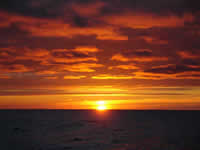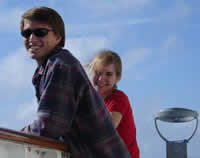


|
The Project Part 3:
Also See: Part 1: Part 2:
|
September 3, 2005
Here Comes The Sun We were up early again today, but not as early as yesterday. The array had to come out of the water at 0600. The sunrise was phenomenal, and I'm not sure if the camera can do it justice. It is interesting how things on the ship seem to go from absolute activity to perfect quiet. When the scientists are casting the CTD, there is much to do and many samples to process. Then there are waiting periods when people get a brief much needed break. The scientists have processed enough to get a beginning picture of the way things are at this spot in the ocean. They get excited as they make discoveries. This morning they are processing all the water from the carboys in order to get a good picture of the growth rate and pattern of the coccolithophores. This afternoon we are sending down more casts and taking more water samples. The mood on the ship is cheery, and there is a feeling of satisfaction in the work being done. The weather has been gorgeous out here, with little wind and mostly clear days. There are some clouds on the horizon, but I don't believe they will develop into much. The ship is like an isolated floating city, with all the functions a city must have: garbage and waste disposal, filtering and creating drinkable water, producing electricity, providing food, lodging people, and even providing entertainment. There is a small "lounge" on the ship that houses a library (a few shelves of books), seating (two sofas), a copy machine and entertainment center to play movies and listen to music. When the crew is not busy, they occupy their time with movies, card games, dominos, and sometimes fishing, when it is permissible. The crew group I chatted with today were the Mates. We have the Chief Mate, Rick, and the First Mate, Ben. Mates are required to hold more licenses and certifications. This is because they are responsible for so much: safety gear, firefighting equipment, medical supplies, charts, and navigational equipment. They also keep navigational watch and ensure the decks are in order. This means keeping up their hours and taking tests to re-certify. Rick, like many others I have met, worked his way up to Chief Mate (which is just below Captain) from the very bottom of the structure. Ben just graduated from a four year program at a Marine Academy. There is more than one way to get to the Mate position on a ship. Math Questions: There are 60 nautical miles in one degree of latitude or longitude. If a ship travels five degrees, how far has it gone in nautical miles? If we started our journey in Newport at 44 degrees N, 124 degrees W and we traveled to 41 degrees N, 132 degrees W, how many degrees did we travel? How many nautical miles? Ocean Trivia: One question that came to my mind when I was preparing for this trip was: "Who started all this oceanography stuff anyway?" Well, the father of oceanography was Lieutenant Matthew Fontaine Maury of the U.S. Navy. He was the first to systematically study the oceans as a full-time career, and to write an English language textbook on oceanography in 1847. If you'd like to know more, do an internet search on his name.
|



